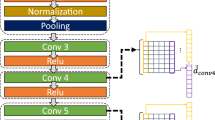Abstract
The biological vision model is devoted to provide a novel technology approach by merging new cognitive visual features with inspired nerve cells cognitive intelligence cortex and try to relate with real worlds object recognition. To perceive an arbitrary natural scene from complex environment perception and sensing in robotic mobility and manipulation on unstructured random natural scene understanding is a challenging problem in the visual image processing. This paper has considered neural network (NN) which is nothing but the grid of “neurons like” nodes. Based on the NN technique,the authors have proposed a new scheme for the scene understanding and recognition. In addition, the significant intellectual visual features are also incorporated for scene expression; those are very crucial and provide cognitive intelligence to robot vision. Due to the dynamic nature of artificial neural network intelligence, we have adapted the attributes of the Gabor filter and Laplacian of Gaussian filter; those play the significant role in the robot visual perception. Through the study of perceptual ability of the natural scene image from complex environment for robot vision is enhanced with the integration of cognitive visual features and the scene expression.








Similar content being viewed by others
References
Itti LL, Koch C (2000) A saliency based search mechanism for overt and covert shifts of visual attention. Vis Res 40(5):1489–1506
Meur OL, Callet PL, Babra B, Thoreau D (2006) A coherent computational approach to model bottom-up visual attention. IEEE 28(5):802–817
Koch C, Ullman S (1985) Shifts in selective visual attention: towards the underlying neuronal circuitry. Hum Neurobiol 4:219–227
Itti L, Koch C, Niebur E (1998) Model of saliency-based visual attention for rapid scene analysis. IEEE Trans Pattern Anal Mach Learn 20(11):1254–1259
Walther D, Koch C (2006) Modeling attention to salient proto-objects. Neural Netw 19(9):1395–1407
Itti L, Koch C (2001) Computational model of visual attention. Nat Rev Neurosci 2(3):194–203
Najmenik J, Geisler WS (2005) Optimal eye movement strategies in visual search. Nature 434(3):387–391
Lee K, Buxton H, Feng J (2005) Cue guided search : a computational model of selective attention. IEEE Trans on Neural Netw 16(4):910–924
Han JW, Ngan KN, Li MJ, Zhang HJ (2006) Unsupervised extraction of visual attention objects in colour images. IEEE Trans Circuits Syst Video Technol 16(1):141–145
Chen Z, Han J, Ngan KN (2006) Dynamic bit allocation for multiple video object coding. IEEE Trans on Multimedia 8(6):1117–1124
Itti L (2004) Automatic foveation for video compression using a neurobiological model of visual attention. IEEE Trans Image Process 13(10):1304–1318
Zhang P, Wang RS (2004) Detecting salient regions based on location shifts and extent trace. J Softw 15(6):891–898
Privitera CM, Stark LW (2000) Algorithm for defining visual regions of interest: comparison with eye fixation. IEEE Trans Pattern Anal Mach Intell 22(9):970–982
Siagian C, Itti L (2007) Rapid biological-inspired scene classification using features shared with visual attention. IEEE 29(2):300–312
Burt PJ, Adelson EH (1983) The Laplacian pyramid as a compact image code. IEEE Trans Commun 31(4):532–540
Afraz SR, Kiani R, Esteky H (2006) Micro simulation of infer temporal cortex influences face categorization. Nature 442:692–695
Afraz DA, Boundar IV, Giese MA (2006) Norm based face encoding by single neurons. Nature 442:572–575
Nolden D (2007) Robust object recognition with cortex-like mechanisms. IEEE Trans Pattern Anal Mach Intell 29(3):411–426
Evans K, Treisman A (2005) Perception of objects in natural scenes: is it really performance. J Exp Psychol Hum Percept Perform 31(6):1476–1492
Thorpe S, Fize D, Marlot C (1996) Speed of processing in the human visual system. Nature 381:520–522
Author information
Authors and Affiliations
Corresponding author
Rights and permissions
About this article
Cite this article
Khan, A., Li, JP., Khan, M.Y. et al. Complex environment perception and positioning based visual information retrieval. Int. j. inf. tecnol. 12, 409–417 (2020). https://doi.org/10.1007/s41870-020-00434-8
Received:
Accepted:
Published:
Issue Date:
DOI: https://doi.org/10.1007/s41870-020-00434-8




